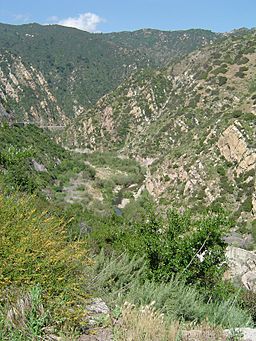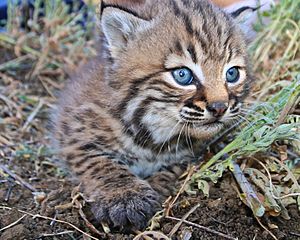Santa Monica Mountains facts for kids
Quick facts for kids Santa Monica Mountains |
|
| Range | |
|
Malibu Canyon in the Santa Monica Mountains
|
|
| Country | United States |
|---|---|
| State | California |
| Counties | Los Angeles, Ventura |
| Part of | Transverse Ranges |
| Borders on | Santa Susana Mountains, Simi Hills, Verdugo Mountains |
| Coordinates | 34°7′13.023″N 118°55′54.348″W / 34.12028417°N 118.93176333°W |
| Highest point | Sandstone Peak |
| - elevation | 3,111 ft (948 m) |
The Santa Monica Mountains are a group of mountains in southern California in the United States.
Contents
Geography
The range extends about 40 mi (64 km) east–west from the Hollywood Hills in Los Angeles to Point Mugu in Ventura County. The mountains form a line between the San Fernando Valley and the Los Angeles Basin, separating "the Valley" on the north and west-central Los Angeles on the south. The Santa Monica Mountains are parallel to Santa Susana Mountains, on the north side the San Fernando Valley. Beginning at the eastern end of the San Fernando Valley, the mountains are bordered to the north by the Los Angeles River. The river flows south after Elysian Park, defining the easternmost edge of the mountains. Mt. Washington, on the other side of the river, has almost the same native plants and weather.
Geology
Scientists who study rocks say that the northern Channel Islands are a westward extension of the Santa Monicas into the Pacific Ocean. The range was created by the Raymond Fault which made the rocks push up and sink down over time. This has made old volcano rock come to the surface. Malibu Creek cuts the mountain range in two.
Weather
The Santa Monica Mountains have dry, warm to humid summers and wet, mild to cool winters. In the summer, the weather is quite dry, which makes the range prone to wildfires. Snow is unusual in the Santa Monica Mountains, since they are not as high as the nearby San Gabriel Mountains.
On January 17, 2007, an unusually cold storm brought snow in the Santa Monica Mountains. Malibu picked up three inches (eight centimeters) of snow – the first measurable snow in five decades (50 years). Snow was reported on Boney Peak, in the winter of 2005; and in March 2006, snow also fell on the summit of the mountain.
Archeology
The mountains have more than 1,000 places where people lived a long time ago, including many places where Tongva and Chumash people lived.
Development and parks
Cahuenga Pass, present-day site of U.S. Route 101, is the easiest pass through the range connecting the Los Angeles Basin to the San Fernando Valley. In the 1800s, two battles were fought there, and the Treaty of Cahuenga was signed nearby. In the heyday of Hollywood movie studios clustered on both sides of it. Sepulveda Pass is the main north–south pass to the west, connecting the Westside to Sherman Oaks via the San Diego Freeway (I-405). Farther west are Topanga Canyon Boulevard (SR 27), Malibu Canyon Road, and Kanan Dume Road. Mulholland Drive runs much of the length of the Santa Monica Mountains, from Cahuenga Pass to Woodland Hills while the Mulholland Highway runs from Woodland Hills to Sequit Point. The eastern end of the range, located in the City of Los Angeles, is more intensively developed than the western end of the range. The city of Malibu runs between the coast and the leading mountain ridge, from Topanga Canyon in the east to Leo Carrillo State Park in the west. The term Malibu Ozarks is sometimes used derogatorily (or ironically) for the unincorporated part of Malibu beyond the leading mountain ridge and lacking an ocean view; the term is often used synonymously with "818 Malibu" (referring to the less desirable San Fernando Valley telephone area code prefix).
Much of the mountains are located within the Santa Monica Mountains National Recreation Area. Preservation of lands within the region are managed in part by the Santa Monica Mountains Conservancy. Over twenty individual state and municipal parks are in the Santa Monica Mountains, including: Topanga State Park, Leo Carrillo State Park, Malibu Creek State Park, Point Mugu State Park, Will Rogers State Historic Park, Point Dume State Beach, Griffith Park, Marvin Braude Mulholland Gateway Park, Charmlee Wilderness Park, Runyon Canyon Park, and the Paramount Ranch.
Places along the north slope of the mountains include (from east to west):
- the Los Angeles communities of:
- Calabasas
- Agoura Hills
- Westlake Village
- Thousand Oaks
- Newbury Park
- Simi Valley
Places along the south slope of the mountains include (from east to west):
- the Los Angeles communities of:
- Beverly Hills
- the unincorporated community of Topanga
- Malibu
Named peaks
| Peak | Height | Notes | |
|---|---|---|---|
| US | SI | ||
| Sandstone Peak | 3111 ft | 948 m | also known as Mount Allen, rising nearly a kilometer high |
| Tri-Peaks | 3010 ft | 917 m | |
| Exchange Peak | 2950 ft | 899 m | |
| Boney Peak | 2825 ft | 861 m | |
| Castro Peak | 2824 ft | 861 m | highest peak in the eastern end of the range |
| Saddle Peak | 2805 ft | 855 m | |
| Calabasas Peak | 2165 ft | 660 m | |
| Temescal Peak | 2126 ft | 648 m | |
| San Vicente Mountain | 1965 ft | 599 m | former site of a Nike missile base, now a Cold War park |
| Clarks Peak | 1965 ft | 599 m | |
| Mesa Peak | 1844 ft | 562 m | |
| Cahuenga Peak | 1820 ft | 555 m | |
| Brents Mountain | 1713 ft | 522 m | |
| Mount Lee | 1640 ft | 500 m | the Hollywood Sign is on the southern slope, at exactly half a kilometer high |
| Mount Hollywood | 1625 ft | 495 m | |
| Mount Chapel | 1622 ft | 494 m | |
| Mount Bell | 1587 ft | 484 m | |
| La Jolla Peak | 1567 ft | 478 m | |
| Laguna Peak | 1457 ft | 444 m | |
| Mugu Peak | 1266 ft | 386 m | the westernmost peak in the range, rising directly from the beach |
Los Angeles River
- Further information: Los Angeles River
The southwestern headwaters of the Los Angeles River are in the Santa Monica Mountains. The Los Angeles River also forms the northern boundary of the mountains from the easternmost part of the San Fernando Valley to Elysian Park, where the river turns south, thereby defining the easternmost part of the mountain range.
Griffith Park
- Further information: Griffith Park
Griffith Park and finally Elysian Park are the eastern end of the Santa Monica Mountains. Griffith Park is separated from the rest of the Santa Monica Mountains to the west by the Cahuenga Pass, over which the 101 Freeway passes from the San Fernando Valley into Hollywood. Elysian Park is the easternmost part of the mountains and is bordered by the Los Angeles River to the east.
Wildlife
The Santa Monica Mountains are in the California chaparral and woodlands ecoregion and are covered by hundreds of local plant species, some of which are very rare, and others of which have become popular ornamentals. The range is host to an immense variety of wildlife, from mountain lions to the endangered steelhead. The mountain lion population within the Santa Monica Mountains (which includes the Simi Hills & Santa Susana Pass) is severely depleted with only seven known living adult individuals. The primary cause of the decline is due to a combination of traffic related mortality (three from the area were killed within a matter of months), anti-coagulants ingested from human-poisoned prey (two individuals within the Simi Hills) and attacks by other, more dominant mountain lions (an elder male, known as P1, killed both his son and his mate. This is thought to be due to a lack of space available.) Snakes are common but only occasionally seen – the Southern Pacific Rattlesnake (the only venomous species), Mountain Kingsnake, California Kingsnake, Gopher snake, and Garter snake.
Other pages
Images for kids
-
Boney Mountain is sacred to the Chumash people.
-
Heart leaf penstemon, Keckiella cordifolia, along the Backbone Trail in the Santa Monica Mountains
See also
 In Spanish: Sierra de Santa Mónica para niños
In Spanish: Sierra de Santa Mónica para niños










